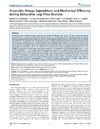Identificador persistente para citar o vincular este elemento:
https://accedacris.ulpgc.es/jspui/handle/10553/6587
| Título: | Anaerobic energy expenditure and mechanical efficiency during exhaustive leg press exercise | Autores/as: | Gorostiaga, Esteban M. Navarro-Amézqueta, Ion Cusso, Roser Hellsten, Ylva Calbet, Jose A L Guerrero, Mario Granados, Cristina González-Izal, Miriam Ibáñez, Javier Izquierdo, Mikel |
Clasificación UNESCO: | 241106 Fisiología del ejercicio | Palabras clave: | Lactate ATP Energy Exercise Training |
Fecha de publicación: | 2010 | Publicación seriada: | PLoS ONE | Resumen: | Information about anaerobic energy production and mechanical efficiency that occurs over time during short-lasting maximal exercise is scarce and controversial. Bilateral leg press is an interesting muscle contraction model to estimate anaerobic energy production and mechanical efficiency during maximal exercise because it largely differs from the models used until now. This study examined the changes in muscle metabolite concentration and power output production during the first and the second half of a set of 10 repetitions to failure (10RM) of bilateral leg press exercise. On two separate days, muscle biopsies were obtained from vastus lateralis prior and immediately after a set of 5 or a set of 10 repetitions. During the second set of 5 repetitions, mean power production decreased by 19% and the average ATP utilisation accounted for by phosphagen decreased from 54% to 19%, whereas ATP utilisation from anaerobic glycolysis increased from 46 to 81%. Changes in contraction time and power output were correlated to the changes in muscle Phosphocreatine (PCr; r = -0.76; P<0.01) and lactate (r = -0.91; P<0.01), respectively, and were accompanied by parallel decreases (P<0.01-0.05) in muscle energy charge (0.6%), muscle ATP/ADP (8%) and ATP/AMP (19%) ratios, as well as by increases in ADP content (7%). The estimated average rate of ATP utilisation from anaerobic sources during the final 5 repetitions fell to 83% whereas total anaerobic ATP production increased by 9% due to a 30% longer average duration of exercise (18.4 +/- 4.0 vs 14.2 +/- 2.1 s). These data indicate that during a set of 10RM of bilateral leg press exercise there is a decrease in power output which is associated with a decrease in the contribution of PCr and/or an increase in muscle lactate. The higher energy cost per repetition during the second 5 repetitions is suggestive of decreased mechanical efficiency. | URI: | https://accedacris.ulpgc.es/handle/10553/6587 | ISSN: | 1932-6203 | DOI: | 10.1371/journal.pone.0013486 | Fuente: | Plos One [ISSN 1932-6203], v. 5 (e13486) |
| Colección: | Artículos |
Vista completa
Citas SCOPUSTM
38
actualizado el 08-jun-2025
Citas de WEB OF SCIENCETM
Citations
37
actualizado el 08-jun-2025
Visitas
72
actualizado el 10-feb-2024
Descargas
131
actualizado el 10-feb-2024
Google ScholarTM
Verifica
Altmetric
Comparte
Exporta metadatos
Este elemento está sujeto a una licencia Licencia Creative Commons

